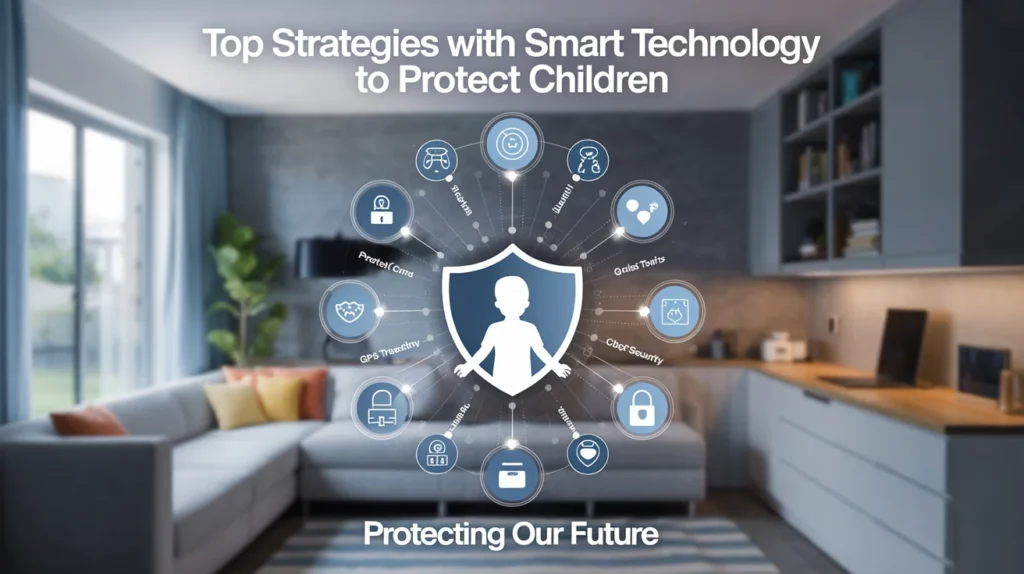In today’s digital world, children are more connected than ever. From online learning to social apps, kids interact with technology daily.
While it offers excellent opportunities, it also brings risks. That’s why parents need competent and reliable ways to ensure their safety.
This article explores the top strategies with smart technology to protect children using effective, secure, and creative methods.
These strategies are easy to apply and focus on building a safer digital environment for kids.
Using AI-Powered Parental Control Apps
Parental control apps have come a long way. Modern apps use artificial intelligence to detect threats, monitor screen time, and block harmful content.
They help parents manage what their kids see online without invading their privacy. These tools are reactive and proactive, identifying potential dangers before they happen.
AI-powered apps like Qustodio, Bark, and Norton Family analyze online behaviour patterns. They alert parents to inappropriate content, cyberbullying, or harmful searches.
These apps also allow remote control, so parents can pause internet access or set usage limits anytime.
Setting Up Smart Home Safety Systems

Smart homes are not just about comfort; they also offer advanced safety. Smart doorbells, cameras, and locks can protect children from physical threats at home.
These systems allow parents to monitor who comes in and out of the house in real time. Motion detection and facial recognition provide alerts for any unusual activity.
By linking to mobile devices, parents can receive instant updates. If a child tries to leave home alone or a stranger approaches, the system notifies the guardian immediately.
Smart safety tools give parents peace of mind, especially when kids are home alone after school.
Educating Children Through Interactive Safety Apps
Technology isn’t only for monitoring; it can be a tool to teach safety as well. Interactive apps designed for children help them learn how to stay safe online and offline. These apps use games, stories, and quizzes to engage young users in a fun and educational way.
Children learn about topics like online privacy, stranger danger, and cyberbullying. Apps like NetSmartz and Safe Kids empower kids with knowledge. Instead of scaring them, these tools make them aware and alert.
Key benefits include:
- Builds awareness of digital threats from an early age
- Encourages responsible internet behaviour through rewards
- Supports both independent learning and parent-child discussions
Monitoring with GPS-Enabled Smartwatches
Smartwatches made for children come with GPS tracking, SOS buttons, and calling features. These wearables are ideal for younger kids who don’t use smartphones yet.
Parents can track their child’s location in real-time, set safe zones, and receive alerts if the child leaves a particular area.
These devices are lightweight, fun to wear, and easy to use. Many smartwatches also limit access to strangers by only allowing pre-approved contacts.
Advantages of GPS smartwatches:
- Real-time tracking with map view
- Panic button sends emergency alert instantly
- Two-way calling with limited distractions
Installing Smart Internet Filters
Children often unintentionally encounter harmful websites. Smart internet filters help prevent this by analyzing and blocking sites based on their content. These systems use cloud-based AI to detect and block inappropriate, violent, or unsafe sites instantly.
These filters can be applied at the device level or through home Wi-Fi routers. Parents can also set up different profiles based on age and usage needs. Some filters even provide activity reports for better tracking.
Creating Screen-Free Zones Using Smart Devices
Smart plugs and timers can help parents control screen time without arguments. You can enforce screen-free zones at home by automating when TVS, gaming consoles, or Wi-Fi routers turn off.
This helps build healthier habits and encourages children to spend more time on physical activities and studies.
You can also use smart speakers to announce digital detox hours. This creates a more balanced tech-life routine at home.
Using AI-Based Content Moderation on Social Platforms
Social media can expose kids to harmful content, fake news, and online predators. Thankfully, some platforms now offer AI-based moderation tools.
These smart systems flag and hide dangerous content, detect hate speech, and even alert users about suspicious messages.
Parents can also use third-party tools to monitor their child’s social media without accessing private conversations. This strikes a balance between safety and trust.
Encouraging Digital Literacy with Child-Friendly Platforms
Teaching digital skills is as essential as setting limits. Child-friendly platforms like YouTube Kids and Google Family Link create a safe space for learning.
These tools allow content filtering, screen time tracking, and even educational resources tailored for kids.
When children use safe, controlled environments, they learn to navigate digital platforms responsibly. These platforms also promote curiosity and creativity while reducing exposure to harmful media.
Other effective digital literacy strategies include:
- Guiding kids on how to spot scams and phishing messages
- Teaching password safety and account security
- Encouraging open communication about digital experiences
Enabling Biometric Locks and Facial Recognition
Biometric systems like fingerprint locks and facial recognition give kids better device control and enhanced privacy.
These tools are especially useful for teens who manage their own devices. Biometric access ensures that no unauthorized user can access sensitive apps, files, or messages.
It also reduces the chance of children’s devices being misused or stolen. Some educational tablets and smartphones come preloaded with biometric tech to improve user security.
Building Stronger Digital Habits Through Routine
Smart technology is effective only when combined with good habits. Create tech routines that include device breaks, educational app usage, and sleep-friendly screen limits. Use digital calendars or timers to build consistency.
This also helps children develop time management skills and balance entertainment with learning.
Habits that boost smart safety include:
- Weekly screen time reviews
- Scheduled check-ins on online activity
- Joint sessions of tech use for better bonding
Conclusion:
Adopting top strategies with smart technology to protect children is no longer optional; it’s a modern necessity. From AI-based monitoring to child-friendly learning platforms, technology offers powerful tools to ensure child safety.
However, these tools work best with active parenting, communication, and habit-building.
Children need freedom, but with guidance. Smart tech helps parents offer that freedom in a safe and controlled way.
Protect your child today using these intelligent, proactive tools designed for a safer tomorrow.
Frequently Asked Questions:
Q1: What is the best age to start using smart technology to protect kids?
Start as early as 5–6 years, using age-appropriate devices and safety tools.
Q2: Can smart devices replace parental supervision?
No. Technology supports parenting but doesn’t replace active involvement and communication.
Q3: Are GPS smartwatches safe for kids?
Yes, if from trusted brands with privacy protections and limited features.
Q4: How often should I review my child’s device usage?
Weekly reviews help build trust and catch potential issues early.
Q5: Question: What are the Top Strategies with Smart Technology to Protect Children?
Using GPS trackers, parental control apps, smart cameras, and AI filters are top strategies with smart technology to protect children effectively.




